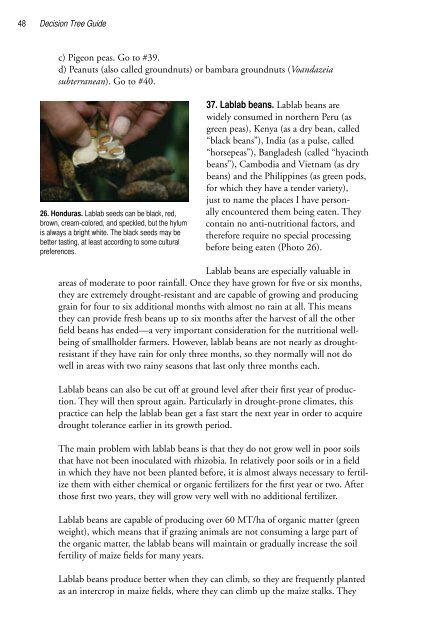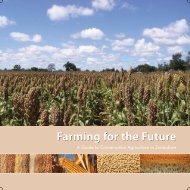48Decision Tree Guidec) Pigeon peas. Go to #39.d) Peanuts (also called groundnuts) or bambara groundnuts (Voandazeiasubterranean). Go to #40.26. Honduras. Lablab seeds can be black, red,brown, cream-colored, and speckled, but <strong>the</strong> hylumis always a bright white. The black seeds may bebetter tasting, at least according to some culturalpreferences.37. Lablab beans. Lablab beans arewidely consumed in nor<strong>the</strong>rn Peru (asgreen peas), Kenya (as a dry bean, called“black beans”), India (as a pulse, called“horsepeas”), Bangladesh (called “hyacinthbeans”), Cambodia and Vietnam (as drybeans) and <strong>the</strong> Philippines (as green pods,for which <strong>the</strong>y have a tender variety),just to name <strong>the</strong> places I have personallyencountered <strong>the</strong>m being eaten. Theycontain no anti-nutritional factors, and<strong>the</strong>refore require no special processingbefore being eaten (Photo 26).Lablab beans are especially valuable inareas of moderate to poor rainfall. Once <strong>the</strong>y have grown for five or six months,<strong>the</strong>y are extremely drought-resistant and are capable of growing and producinggrain for four to six additional months with almost no rain at all. This means<strong>the</strong>y can provide fresh beans up to six months after <strong>the</strong> harvest of all <strong>the</strong> o<strong>the</strong>rfield beans has ended—a very important consideration for <strong>the</strong> nutritional wellbeingof smallholder farmers. However, lablab beans are not nearly as droughtresistantif <strong>the</strong>y have rain for only three months, so <strong>the</strong>y normally will not dowell in areas with two rainy seasons that last only three months each.Lablab beans can also be cut off at ground level after <strong>the</strong>ir first year of production.They will <strong>the</strong>n sprout again. Particularly in drought-prone climates, thispractice can help <strong>the</strong> lablab bean get a fast start <strong>the</strong> next year in order to acquiredrought tolerance earlier in its growth period.The main problem with lablab beans is that <strong>the</strong>y do not grow well in poor soilsthat have not been inoculated with rhizobia. In relatively poor soils or in a fieldin which <strong>the</strong>y have not been planted before, it is almost always necessary to fertilize<strong>the</strong>m with ei<strong>the</strong>r chemical or organic fertilizers for <strong>the</strong> first year or two. Afterthose first two years, <strong>the</strong>y will grow very well with no additional fertilizer.Lablab beans are capable of producing over 60 MT/ha of organic matter (greenweight), which means that if grazing animals are not consuming a large part of<strong>the</strong> organic matter, <strong>the</strong> lablab beans will maintain or gradually increase <strong>the</strong> soilfertility of maize fields for many years.Lablab beans produce better when <strong>the</strong>y can climb, so <strong>the</strong>y are frequently plantedas an intercrop in maize fields, where <strong>the</strong>y can climb up <strong>the</strong> maize stalks. They
Decision Tree Guide49grow somewhat slowly during <strong>the</strong>ir first few months, so <strong>the</strong>y never become aproblem for <strong>the</strong> maize. When intercropped with maize, <strong>the</strong>y should be plantedabout three seeds per square metre. If weed control is particularly important, fourseeds could be tried, though <strong>the</strong> early slow growth of lablab beans makes <strong>the</strong>mless able to control weeds than, for example, mucuna. Lablab beans should not beintercropped with sorghum or millet. Since <strong>the</strong> stems of <strong>the</strong>se crops are not verystrong, <strong>the</strong> lablab beans will cause <strong>the</strong> sorghum and millet to fall over.Animals very much like lablab beans. Cattle will prefer <strong>the</strong>m to virtually anyo<strong>the</strong>r fodder. Since <strong>the</strong> plant as a whole contains about 23% protein, it is a veryvaluable animal feed. Where cattle are allowed to graze freely during <strong>the</strong> dryseason, small plots of lablab beans will be grazed down to <strong>the</strong> ground, unless <strong>the</strong>yare protected from <strong>the</strong> animals. This greatly reduces <strong>the</strong> value of <strong>the</strong> lablab bean,since it does not produce much seed before <strong>the</strong> dry season starts when most of<strong>the</strong> organic matter needed for soil fertility has not yet been produced. Lablabbeans are <strong>the</strong>refore largely useless when planted where <strong>the</strong>re are free-rangingcattle, sheep or goats.27. Honduras. These lablab plants, intercroppedwith maize, will stay green and produce seeds allthrough a 6-month dry season, <strong>the</strong>reby providinghighly nutritional, vitamin-rich fodder for cattle rightthrough <strong>the</strong> time when animals have <strong>the</strong> leastfodder to eat.On <strong>the</strong> o<strong>the</strong>r hand, for farmers who canensure that <strong>the</strong> lablab beans are consumedby <strong>the</strong>ir own animals, lablab beans can bea wonderful feed. Cattlemen in Hondurasgrow lablab beans with <strong>the</strong>ir maizeduring <strong>the</strong> wet season. After <strong>the</strong> maize isharvested, <strong>the</strong>y let <strong>the</strong>ir cattle feed on <strong>the</strong>lablab plants and maize stalks during <strong>the</strong>entire 6-month dry season. This way, <strong>the</strong>iranimals continue to gain weight even during<strong>the</strong> long dry season (Photo 27).Probably <strong>the</strong> best way to manage freerangingcattle is to have farmers grow <strong>the</strong>lablab beans for several years, ei<strong>the</strong>r infenced areas or areas where cattle and o<strong>the</strong>r animals have no access. Once farmersrealize <strong>the</strong> value of <strong>the</strong> lablab bean for human consumption and also for dry seasongrazing and fertilizing <strong>the</strong> soil, <strong>the</strong>y will often make village-level decisions tolimit <strong>the</strong> grazing areas of <strong>the</strong> cattle or to control grazing completely. This processis facilitated when <strong>the</strong> cattle-owners have lablab beans in <strong>the</strong>ir own fields, and<strong>the</strong>refore will have plenty of dry season fodder.Use S23, S24, or S71, and <strong>the</strong>n go to #5.38. Cowpeas, rice beans and mungbeans. Cowpeas, rice beans and mungbeans allbelong in <strong>the</strong> genus Vigna. They grow in similar ways, except that certain varietiesof cowpeas and rice beans crawl or climb, while o<strong>the</strong>rs are bushy. The bushy-typeVignas can be intercropped with maize, sorghum or millet, but <strong>the</strong> climbing vari-
















